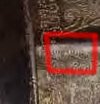A few weeks ago the subject of Jambiyas came up, and I mentioned I have an old one which looks Nepali-made. It turns out that not all the pix of it were sunk with Photopoint; I found these two on my hard drive. Pix are not mine but the seller's.
Here's the whole thing.

You'll notice that its overall form, especially the blade profile and geometry, are more similar to Arabian and South Indian jambiya styles, rather than to the elegant North Indian styles adjacent to Nepal.
What I think gives this away as being Nepali are:
1. the scabbard -- tooled leather over wood, with brass tip -- which has that characteristic khukuri appearance;
2. the engraving on the blade, which is often found on khukuris but never on Arabian jambiyas. You can see some of that pointille engraving in this picture:

I for the life of me can't figure out if the hilt's wood or horn. But again, it has that same solid feel khukuri hilts do. Not that Arab and South Indian jambiya hilts are flimsy, but both usually incorporate telltale decorative features that make identification easier. Because those features are absent, and for the other reasons mentioned above, I'm pretty confident this thing's a bona fide Nepali jambiya.
But again, it has that same solid feel khukuri hilts do. Not that Arab and South Indian jambiya hilts are flimsy, but both usually incorporate telltale decorative features that make identification easier. Because those features are absent, and for the other reasons mentioned above, I'm pretty confident this thing's a bona fide Nepali jambiya.
While it may seem out of place to find a jambiya made in old Nepal, it seems less strange when we recall the pix from Uncle Bill's visit to the Prithvi Narayan Shah display, which included a whole bunch of "foreign" Islamic arms -- Khyber knives, yataghans, and pesh kabzes among them. Apparently the Gurkhas back in the day were proficient in handling other blades in addition to khukuris!
Here's the whole thing.

You'll notice that its overall form, especially the blade profile and geometry, are more similar to Arabian and South Indian jambiya styles, rather than to the elegant North Indian styles adjacent to Nepal.
What I think gives this away as being Nepali are:
1. the scabbard -- tooled leather over wood, with brass tip -- which has that characteristic khukuri appearance;
2. the engraving on the blade, which is often found on khukuris but never on Arabian jambiyas. You can see some of that pointille engraving in this picture:

I for the life of me can't figure out if the hilt's wood or horn.
While it may seem out of place to find a jambiya made in old Nepal, it seems less strange when we recall the pix from Uncle Bill's visit to the Prithvi Narayan Shah display, which included a whole bunch of "foreign" Islamic arms -- Khyber knives, yataghans, and pesh kabzes among them. Apparently the Gurkhas back in the day were proficient in handling other blades in addition to khukuris!

